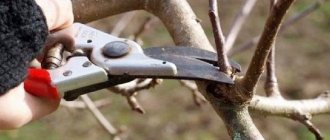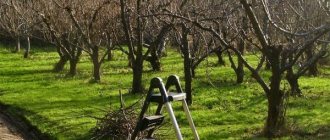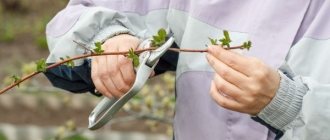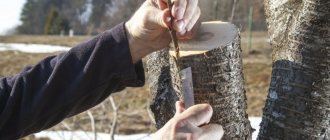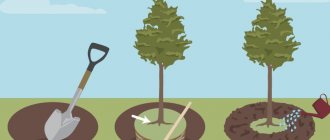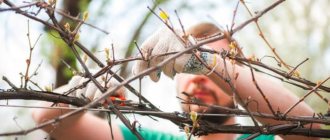After planting, the apple tree seedling begins to be diligently fertilized so that it begins to grow as quickly as possible, watered and protected from various diseases and pests that like to feast on young shoots. But some are unsure about the importance of pruning an apple tree seedling after planting. There are a number of compelling arguments that speak in favor of the procedure.
Pruning an apple tree seedling.
Why do young apple trees need to be pruned?
It would seem, why trim newly planted plants, because they are still so young and have not had time to grow the required number of shoots. However, it is precisely in the first years of the apple tree’s life that it is necessary to begin to form the crown in order to make it what we would like to see in the future. Thus, pruning of young apple trees is primarily carried out to give the correct crown shape. And an equally important requirement is to stimulate the growth of a large number of lateral fruit-bearing branches.
Why is the crown formed and when to do it?
The formation of the “cap” is a very important process that affects the yield of a fruit tree; the branches become stronger, withstand bad climatic conditions, and do not break off in wind, snow or rain.
Pruning is necessary to create the correct shape of the top; for this purpose, strong skeletal branches are left and young fruiting ones are pinched. The main thing is to do everything correctly, otherwise you can ruin the apple tree.
Many novice gardeners skip pruning, considering it optional, but this is not true because:
- A thick and branchy crown causes branches to break off, wounds appear that do not heal, and the apple tree begins to hurt. Recovery will take a lot of effort and time, and part of the harvest will be lost. Gradually the condition of the tree will deteriorate and it will die.
- Frequent and dense foliage causes diseases; as a result, apples become tasteless and unattractive in appearance.
- An unkempt tree produces small and sour fruits. Since the sugar obtained during photosynthesis begins to be spent on leaves and branches, and not on apples. The more shoots an apple tree has, the more nutrients are spent on their maintenance, and there are not enough of them. As a result, the shoots freeze, which leads to a weakening of the plant as a whole.
- The correct shape will help to withstand the weight of the apples and not bend under its own weight, since after planting the tree is very brittle and can break from the weight of the fruit and harsh climatic conditions. Pruning can maintain a balance between the durability of the branches and the load of fruit.
- Due to the thick cap of leaves, sunlight does not reach all branches, the fruits ripen more slowly and become of poor quality. With good lighting, the fruiting period is reduced by 2 years, and the apples will be juicy and tasty, and the plant itself will grow quickly.
- A properly selected shape helps you pick fruit without any extra effort at a comfortable height.
If the tree is not cared for for four years, it will go wild, the fruits will be tasteless, sour and small.
Features of apple tree pruning
There are several important features of pruning a young seedling that must be taken into account before starting the procedure. Inexperienced gardeners may think that pruning is a rather complicated operation. However, with proper preparation it will be quite easy to carry out.
Which shoots can definitely be removed?
Of course, you need to monitor the crown itself and choose the branches that are cut. However, you can definitely remove shoots that grow, overshadowing the central conductor, or those that will interfere with the skeletal ones. You can also remove shoots that have been broken or damaged by pests or exposure to low temperatures.
How to cut into a ring
The ring pruning method is one that involves the complete removal of the branch. There is always a small influx at the base, which is called a ring. You will need to cut through it at an angle. The peculiarity of this process is that thanks to this influx, the wound will heal much faster.
Scheme of correct cutting for a ring.
If it is cut much higher than the surface, a stump will remain, from which a hollow will quickly form. If the influx is significantly lower, then the crop will hurt longer and heal the wounds.
How to cut to a bud
Bud pruning is the partial removal of shoots. The cut is made so that the top layer is above the bud. For young apple trees, it is extremely important to cut to the outer bud, which will stimulate the appearance of a large number of side shoots.
Bud pruning options.
How to isolate slices
Large cuts must be covered. This is done to prevent pathogenic infections or fungal spores from entering the plant tissue. They need to be smeared with a dense material, completely catching the wood, but not catching the bark.
Garden paint or garden var
Most often they talk about using garden pitch for these purposes. This purchased material is effective and easy to use. When applied correctly, it forms a light film that protects the branch tissue. Special garden paint is also sold, which is used to cover wounds.
It is worth understanding that a layer of paint will be more airtight, and varnish should not be used after pruning in the fall, because under the influence of low temperatures it becomes brittle.
garden tools
Gentle pruning of seedlings is possible only when using special equipment. In order to tidy up an adult tree, you will need a lopper and a garden saw, but for seedlings, a pruner will be enough. It will do a great job with thin branches. Requirements for pruners:
- sharpness, correct sharpening to obtain perfectly even cuts;
- safety and ease of use by the gardener;
- narrow tips so that you can trim even hard-to-reach branches;
- strength to withstand even extreme pressure.
It is also advisable to evaluate the handle of the tool: it should fit comfortably in your hand and not slip. It is better if it is painted in a bright color - then it will be easier to find the pruning shears if, for example, it falls into the grass.
It would be a good idea to purchase a special garden knife. It is sharp, specially shaped, and is designed for cleaning out irregularities formed after pruning, removing areas of rot, cutting out unhealthy roots, and so on. In addition, do not forget that a fresh open cut on a tree is fertile ground for the penetration of fungi and other pathogens. Therefore, it is necessary to have tools for processing sections in your inventory. This can be garden pitch, a special varnish for covering cuts (“artificial bark”), clay, natural-based paints and others.
On the first day after pruning, it is not recommended to cover the wound with varnish or other means. First you need to treat it with a disinfectant solution and let it dry. After 2-3 days in dry weather, you can start sealing the cuts.
Technique for pruning an apple tree from the moment of planting
It is necessary to begin the formation of the crown immediately after planting, if it occurred in the spring.
Technique for pruning an apple tree during its growth.
annual apple tree
The procedure for pruning an annual apple tree seedling is carried out in order to begin to form a crown and lay the foundation for future skeletal branches. This procedure will also help stimulate the appearance of lateral branches on which fruits will be set in the future. In order to properly prune a young annual apple tree, you need to cut the trunk at a height of 80 cm. If the seedling already has several branches, then the shoots need to be cut at a height of about 70 cm or slightly higher. Of these, you need to choose only two or three that will form the skeleton.
Two year old apple tree
On a two-year-old apple tree, lateral shoots are already appearing. The principle is the same as when pruning a young seedling with branches. It will be necessary to partially remove the branches, choosing the strongest ones, and remove only those that grow at an acute angle, because they often break off.
Three year old apple tree
It is very important at the three-year stage to ensure that the apple tree manages to maintain a balance between the root system and the vegetative one. Therefore, it is necessary to remove the remaining shoots of several buds, and, if necessary, install stretch marks between the skeletal branches of the first tier or pull them down.
In this case, the central conductor will need to be cut, but leave a length so that it rises 30 cm above the total mass of shoots.
Tips for beginners
Before you begin thinning or pruning, you should take a close look at the tree and think over a plan for its reconstruction. During the work process, you can make certain changes. Shortening the shoots should be completed before the buds open, and you can remove the entire branch, which greatly shades the sun, even in summer . A very important operation is to regularly limit the growth of the tree. It should be carried out regularly throughout the entire fruiting period.
To do this, remove the upper part of the trunk with two or three large branches. This procedure is performed at a height of 2-2.5 meters from the main lower branch. The tops of the upper shoots are cut off at the same level. After lightening the crown, large and fast-growing shoots called “tops” can form. They should be removed in a timely manner, otherwise another crown from these shoots will form above the main crown. The false crown turns out to be so dense that it completely blocks the penetration of sunlight to the fruits and leaves.
Pruning should be done with a well-sharpened garden tool. Before trimming, cutting edges should be disinfected with an alcohol-containing liquid. After trimming, the cut site is treated with a solution of copper or iron sulfate. Sections with a diameter of more than 3 cm must be covered with a special compound. A very thick and long branch, so that it does not break off at the trunk under its own weight, must be removed in two steps. First, remove the outer part by 1/2 of the length, and then carefully make a cut near the trunk. Sawing should only be done from below. This will avoid breaking and splitting of the branch. All thinning and shortening work must be done in dry weather and in the evening.
How to cover a saw cut on an apple tree, read this link.
Deadlines
The exact timing of the pruning procedure depends on many factors. These may be the climatic conditions of the region, the characteristics of the apple tree variety, the type of soil and the planting location. Also, weather conditions may differ from year to year, so it is impossible to clearly focus on the same date.
The process of pruning an apple tree in the spring.
in spring
Spring pruning of young seedlings should be scheduled on a fine day, when the air temperature has already reached 10 degrees during the day. But at the same time, it is necessary to ensure that the buds have not yet begun to bloom.
in autumn
Pruning is carried out at a time when the entire harvest has already been harvested, the leaves have fallen from the apple trees and the tree trunk has been cleared. However, it will also be necessary to observe a sense of proportion and ensure that there are about 21 days left before the onset of cold weather. During this time, the plant will have time to heal its wounds.
Gardener mistakes
Any mistakes made during pruning of the apple tree in the spring or subsequent care for it will negatively affect the plant. That is why it is so important to strictly follow all work rules.
The most common errors:
- Lack of timeliness of work. If you prune too early (before the end of frost), this will lead to cold damage to the wood, and if you prune too late (at the peak of sap flow) it will weaken the tree.
- Neglecting pruning. If you do not remove excess branches on an apple tree even for one year, its crown becomes very thick. As a result, the ventilation of the crown and its illumination decrease, and the risk of various diseases increases. The same goes for young trees. With each passing year, it will be more difficult to form the correct crown from a neglected one.
- Incorrect trimming. When pruning branches into a ring, you cannot remove the sag at their base. The cambial tissue will be damaged, and instead of overgrown, a hollow will form at the cut site. This reduces the lifespan of the apple tree.
- Errors in choosing a tool. The hacksaw should have a narrow, thin blade, and the pruning shears should be sharp. All burrs formed on the wood during work should be thoroughly cleaned to a smooth state. Under no circumstances should branches be broken.
- Neglecting putty. Proper pruning does not guarantee a good result: the cut area must be protected with a suitable product. This will prevent the entire tree from becoming infected with viral, fungal or bacterial diseases or insects.
Pruning apple trees in the spring is a must for trees of any age and variety. Removing excess, damaged and dry branches will benefit the tree if you adhere to the chosen pruning pattern. In this case, the apple tree will get sick less often and will certainly delight you with a rich harvest.
Pruning young columnar apple trees
Columnar apple trees are distinguished by the fact that their central conductor is never pruned. Fruiting of the columns begins on the lateral branches, the growth of which must be stimulated. Thus, in the second year of life of a young columnar apple tree, each of the lateral branches must be cut into two buds to stimulate the growth of ringlets. Remove those that grow horizontally; they will not bear fruit.
Pruning diagram for a columnar apple tree.
Artificial crowns
In some gardens you can find decorative crowns of apple trees, the technique is reminiscent of bonsai. They come in various designs. Artificial forms stimulate the productivity of southern varieties; apple trees decorated in this way bear fruit early; the apples, although small, are very tasty, as they are generously endowed with sunlight.
Such trees will look beautiful as separate fragments of the garden. The flat shapes of apple trees create an amazingly beautiful green wall that can be used to zone a separate area. For this method of crown formation, only dwarf trees with a ringed type of fruiting can be suitable. Pruning should be done once a season, and you will also need to make a good frame, since the trees will not withstand the elements.
The branches must be removed in parts, and those that have escaped from the crown must be pinched, bent or tied up. The crown called the “Weeping” apple tree looks very beautiful; the “cap” is formed using the “reverse grafting” method. Three or four cuttings are carefully grafted into the center of the rootstock, buds down.
In the third year, the plant will begin to bear fruit with delicious apples, ensuring high yields and a beautiful and unusual crown. The method can be applied to dwarf apple trees; they will be neat in appearance with a fancy “hat”, which is sure to attract attention.
With such trees you can decorate your garden plot for beauty purposes, and a pleasant bonus will be the abundant fruiting of juicy fruits.
Artificial crown formation is difficult work. Apple trees with such a “hat” will look like a real work of art. The garden will delight you with a beautiful and unusual view, bear delicious, juicy fruits and decorate it with its greenery.
Care after pruning
After the apple tree has been completely pruned, it is necessary to inspect its condition. If wounds or damage are identified, they will need to be treated with an antiseptic solution and then covered with some special agent.
It will be necessary to stimulate the plant to grow, thereby feeding it a little and watering it well.
If a young apple tree was pruned in the spring, then it needs to add a little more fertilizer with nitrogen elements. And if the operation was carried out in the fall, then a mandatory procedure will be to insulate it for the winter.


